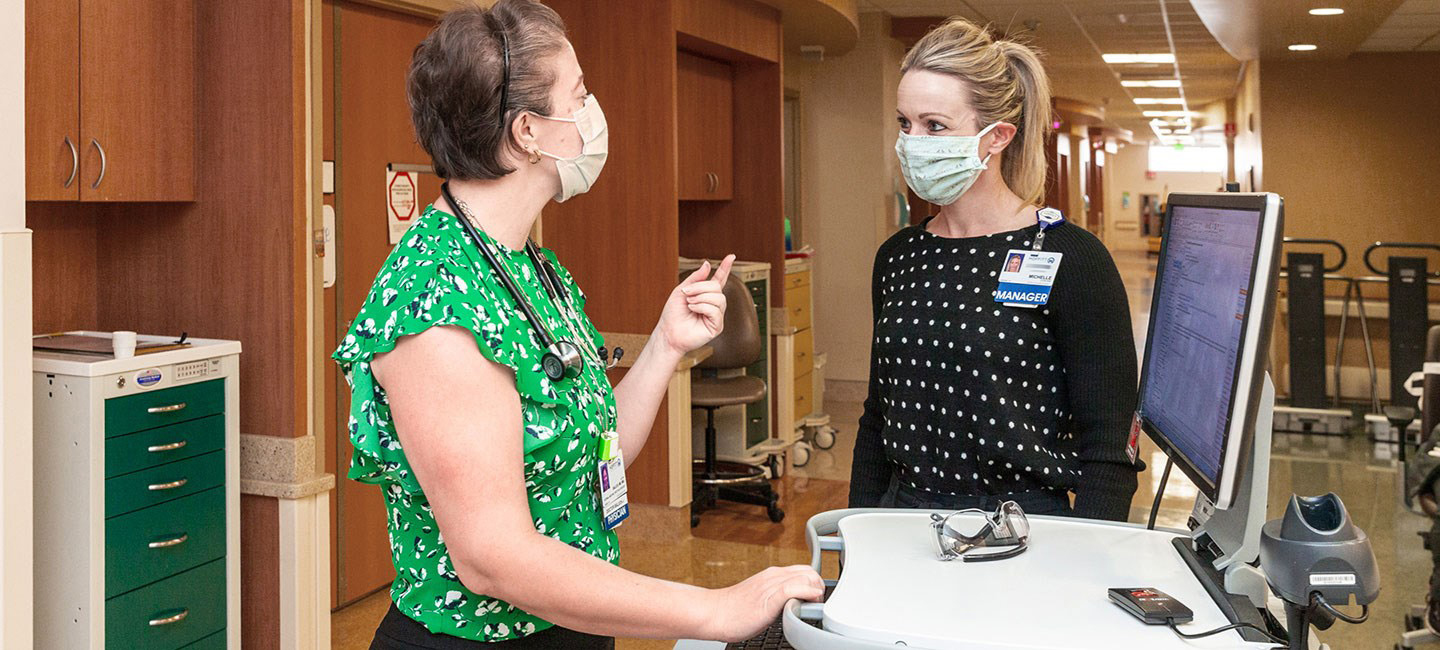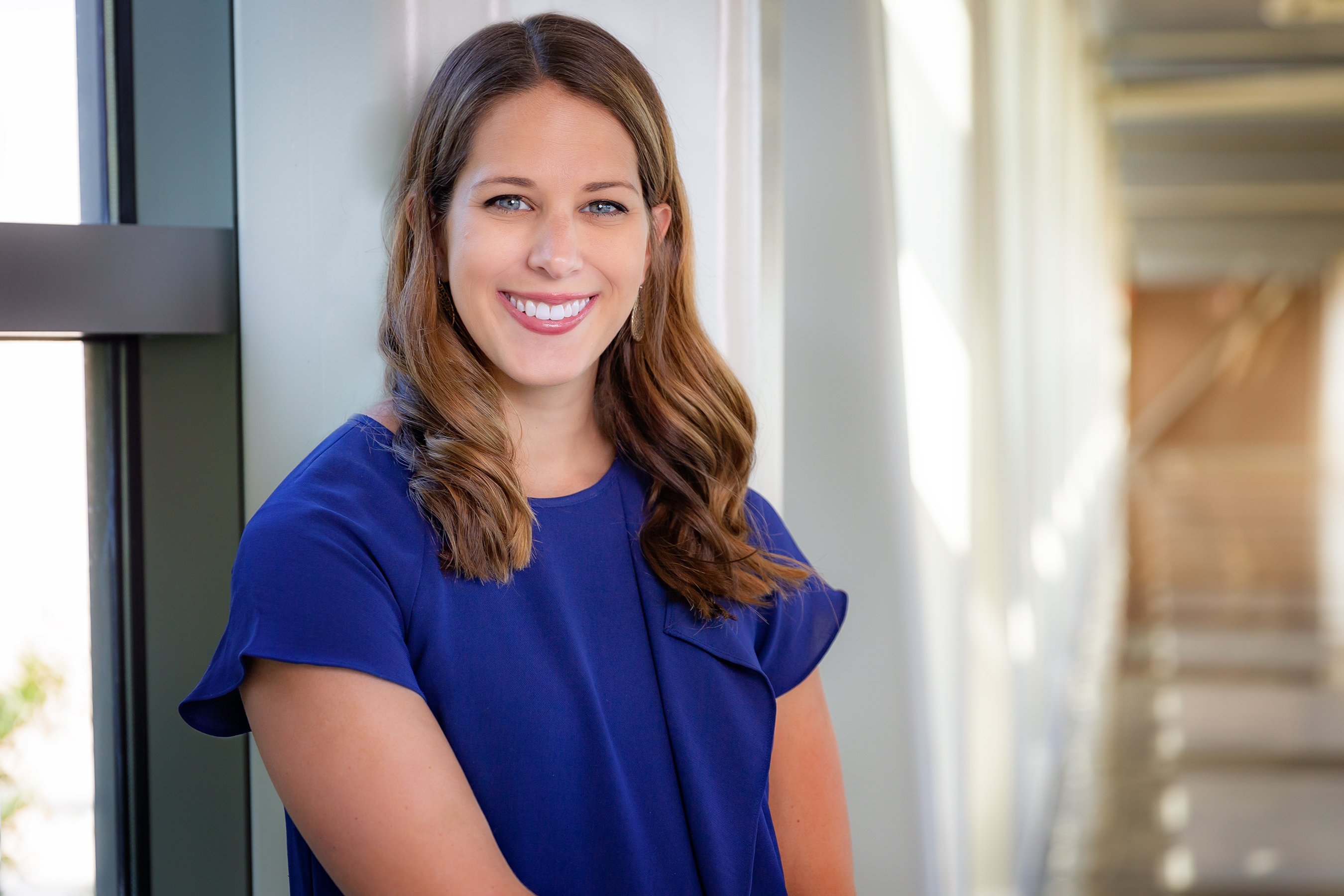Navigating the Waves of a Pandemic
Aliyah Baluch, MD, MSc, a bone marrow transplant infectious disease specialist, isn’t the type to wait for direction. So, in early March, when many were still watching and waiting as COVID-19 swept through the nation, she jumped into action.
“My first concern was, how do I keep my patients safe?” said Baluch, the Moffitt Cancer Center’s 2019 Physician of the Year. “Our patients are the sickest in the building on a regular day, much less during a novel infection.” The bone marrow transplant floor also has positive pressure, so the virus could spread faster there than on a regular hospital floor.
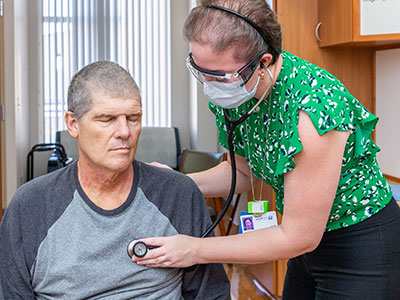
Dr. Aliyah Baluch examines patient Rene Gauthier on the Bone Marrow Transplant Floor.
“Things were changing fast and furious,” recalls Chief Medical Information Officer Randa Perkins, MD. “We didn’t know what was safe and what wasn’t, we didn’t know how long this would last. There were so many questions and we didn’t have the luxury of time or comparison to other sites because every other site was trying to figure out the same thing.”
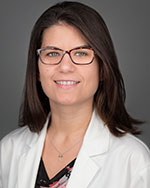
Randa Perkins, MD, Chief Medical Information Officer
As the pandemic intensified, teams across Moffitt came up with a plan to continue treating some of the most immunocompromised patients while keeping them, their families and team members safe. Many of those teams were led by women, and together they were able to navigate the waves of the pandemic in a way many would have not thought possible.
“We all come together for the same mission, just like we do with Moffitt’s primary mission, and we will get things done,” Perkins said. “We have really great people, but in moments of crises, you start to realize the caliber of the colleagues next to you.”
Building a new workflow
It may feel like the COVID-19 pandemic began a lifetime ago. You never leave the house without grabbing a mask, along with your cellphone. Rarely does anyone go in for a handshake or hug.
But in reality, it has been less than a year since the novel coronavirus made its way to the United States. Those early months, especially for health care organizations, posed a foreign and urgent challenge characterized by fear and uncertainty, made even worse by constantly changing information and shifting government recommendations.
The Moffitt teams had to quickly rise above that confusion. They needed new plans for how to treat cancer patients and potential COVID-19 patients, while limiting exposure to the virus. Baluch and the Infectious Diseases Program turned to the Clinical Informatics Department for help. The department, led by Perkins, works as a bridge between IT and the clinics, making sure IT understands how providers work and helping them find new resources to improve their practices.
Together, they built a new workflow for COVID-19 testing from scratch, determined what baseline labs were necessary and created treatment algorithms. A protocol document on how to care for a COVID-19 patient was also created and updated each week. It has provided clinicians with a roadmap on how to test for COVID-19 and how to identify which COVID-19 positive patients meet the criteria for treatment.
Baluch lobbied alongside the Bone Marrow Transplant and Cellular Immunotherapy Program to Moffitt leadership for baseline negative COVID-19 testing prior to starting transplant-related therapy, followed by weekly COVID-19 testing for all hospitalized transplant patients. If a patient tested positive, the transplant would be delayed. Those processes and procedures then spilled over to the rest of the hospital, eventually requiring all patients to undergo COVID-19 testing prior to treatment and surgeries.
“It was the first full-on pandemic type of event we had experienced, but you just have to break it down into palatable pieces,” said Baluch.
It was no easy task; Perkins compares it to playing 4-dimensional chess. Empowering team members to be proactive and have confidence in their decisions made a big difference. Perkins watched in amazement as her team members took on challenges like they were jumping onto a grenade. “As a leader, sometimes the job is getting the right people in the right roles and giving them the space to do what they do best,” she said.
Reallocating resources
With the uncertainty of how the virus would affect the local community, Moffitt first had to prepare to treat COVID-19 patients. Led by Vice President and Chief Nursing Officer Jane Fusilero, MSN, MBA, RN, NEA-BC, nursing teams worked with Infection Prevention to delegate space and resources for caring for these potential patients. Simultaneously, they were creating educational programs to help those on the frontlines not only do their jobs safely, but also address their fears.
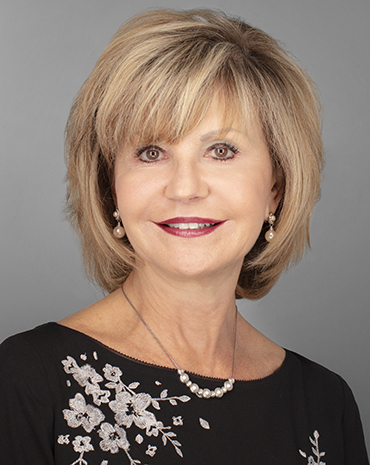
Jane Fusilero, MSN, MBA, RN, Vice President and Chief Nursing Officer
“At the beginning, things were changing almost daily and people were scared,” said Fusilero. “So, we wanted to educate staff about the facts. We rounded to help answer any questions and give the best information we had at the time. And we had to do this repeatedly because things changed all the time. It was a huge component of how we were able to address everyone’s fear and anxiety while providing the safest possible care for our patients.”
One of the biggest challenges was allocating resources and staff. Fusilero and her team had to figure out how to staff screening checkpoints for team members, visitors and patients at multiple hospital entrances and the COVID-19 screening clinic – all with existing team members.
Nurses were now needed not just on patient floors and in clinics, but in what felt like everywhere around the hospital. “When we stopped visitation, we had patients coming in by themselves and many needed escorts,” said Fusilero. “We needed to have availability of transport when we never would have thought of that before because patients always had someone with them to help.”
Nurses not only had to help patients get where they needed to go, but once they got there they often had to play the role of primary caregiver. Without a friend or family member accompanying patients, nurses had to offer emotional support, help take notes and make sure patients fully understood discharge instructions. Nurses worked diligently to help patients feel connected to their loved ones during their hospitalizations.
Nurses are known for rolling up their sleeves when times get tough and getting right to work, and the COVID-19 pandemic was no exception, Fusilero said. In the fall, the team opened up a curbside clinic, which offers select nonchemotherapy injections and other services to patients without having to get out of their cars.
“Looking back, it’s like wow, we actually did all of this,” she said. “We are tired, but we made it and we did it. The whole team deserves a lot of credit for putting in the hours and making it happen in such a smooth way.”
Tapping into telemedicine
The virus primarily spreads through person-to-person contact, so Moffitt had to reduce the number of people at the hospital. The first step was setting up the infrastructure to transition thousands of team members to work from home. Then, Moffitt looked to convert a large number of patient appointments to virtual visits.
While telemedicine was being largely used in primary care, “tele-oncology” has lagged behind because the unique and specialized care is best captured through face-to-face interaction. Before the pandemic, Moffitt was still in a pilot phase of telemedicine, with only 76 providers performing sporadic virtual visits. COVID-19 forced the Virtual Health team, led by Cristina Naso, to quickly ramp up efforts.
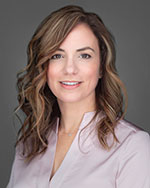
Cristina Naso, Virtual Health Director
“I think the pandemic was an accelerant that threw gas on the fire,” said Naso. “Because of the organization’s commitment to the safety of our patients, it put out an appropriate-use case and guidance. That gave physicians a level of confidence to use the platform and then it became a shared experience.”
At the height of the first wave of the pandemic, more than 200 providers were offering telemedicine and about 30% of all outpatient visits were done virtually. In April, there were more than 6,000 virtual visits and in May, more than 4,000—all of this happening while the teams were still working out the kinks.
A virtual health command center was set up and subgroups met every morning to discuss issues providers, schedulers and patients were having and find solutions. “It was truly triage on a daily basis,” said Naso. “This was the hardest time for everyone.”
The teams also worked hard to make sure translation services continued.
Language Services Focuses on Meeting Needs for Patient Interaction
The teams also had to integrate language services into telemedicine. Moffitt has seven Spanish speaking interpreters around the campuses and relies on a remote video platform for interpretation of other languages.
Whenever possible, in-person interpretation is always best, especially when providers are giving a serious diagnosis or having end-of-life conversations.
“Those types of interactions don’t lend themselves well to remote interpreting and can feel a bit less caring, distant and cold to a patient,” said Prado Antolino, manager of Language Services. “When they are looking at you and you are looking at them, it makes a huge difference.”
When Antolino saw how bad COVID-19 was in her native Spain, she knew she needed to start preparing for the virus here. The interpreters already had the equipment they would need to work remotely, but Antolino had to create guidelines and expectations for interpreters to provide their services virtually. Once those were in place, the team worked with the Virtual Health Department and providers to integrate interpreting services into a telemedicine visit.
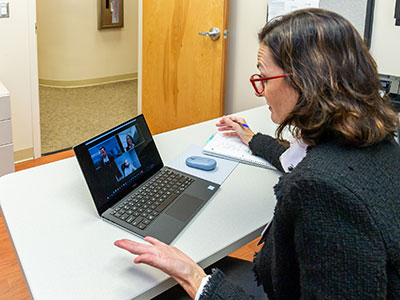
Prado Antolino, manager of Language Services, created guidelines and expectations for interpreters to provide services virtually.
“I think we succeeded because everyone had the same mentality, including the patients, that it is not safe for me to be at the hospital surrounded by people,” said Antolino. “The value we also brought into the equation was that even though the service was provided remotely, it was still provided by our own interpreters, not a stranger.”
The remote interpretation was also successful for deaf patients, who were able to stay safe and still have appropriate language access. Being on video meant they could see the interpreter’s facial expressions much easier than if they were in person wearing a mask.
The interpreters returned to campus in June, and although they still believe in-person interpretation is best, they have realized how big of an asset virtual interpreting can be. It allows the small staff to be able to help even more patients across the multiple campuses. Currently, about 30% of language services are being provided remotely.
Despite the challenges behind the scenes, telemedicine was a huge success from the patient perspective. In April, during the peak of the pandemic, Moffitt patients received the highest score in its history on the Press Ganey survey for patient satisfaction.
“Not only are we seeing the high patient satisfaction and the return users, but we are seeing returning offering,” said Naso. “For me, that tells the story that it works for them, as providers and clinicians, and it works for the patients. So, I think it’s going to be sustainable moving forward.”
Months after the first wave of the pandemic, the new digital initiatives are still going strong.
About 12% of all outpatient visits are being done remotely, with more than 3,000 virtual visits completed in October. There are now more than 300 unique providers who offer the service, and up to 60% of patients who request a virtual visit have had one before.
Patient Experience Team Launches Caregiver Support
Much of the success associated with high patient satisfaction scores and return users of telemedicine can be attributed to Cristina Perez, MBA, and her Patient Experience team. Not only was the team responsible for guiding patients through the virtual visit transition, but also for coming up with creative solutions when the no visitor policy went into effect.
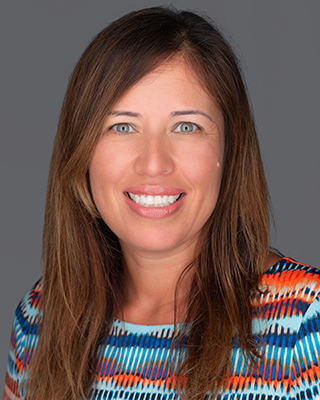
“That was when it became all hands on deck because we had to help inform patients they could not bring a caregiver, but also look for ways to keep patients connected,” said Perez.
In early April, Patient Experience launched the Caregiver Virtual Support Initiative to virtually connect patients and caregivers. Using their own device or a Moffitt-provided iPad, patients could now video chat with loved ones who couldn’t physically be there. The team deployed more than 2,000 iPads between April and November to patients who needed a device.
For those caregivers waiting outside or in cars during appointments, the Patient Experience team partnered with the Foundation to set up a caregiver lounge in the Stabile Research Building atrium, equipped with comfortable socially distanced seating, television sets, pre-packaged snacks and iPads to connect with patients.
For inpatients, Patient Experience relied on nurses to make sure everyone stayed connected.
“Some of our patients are hospitalized for weeks and that’s a long time for a cancer patient to be without a loved one, and caregivers are at home and worried,” said Perez. “So, we worked closely with the nursing team to ensure that caregivers were getting daily calls from patients and that they had the option to video chat with the patient with the iPads we had on the floors.”
Even though visitors are allowed back on campus, the Caregiver Support Initiative is still being used to connect out-of-town family members to patients. Using the platform, Patient Experience has connected eight family members during one virtual visit and even connected a patient with her husband serving in Afghanistan.
Not stopping the science
The pandemic also changed the way Moffitt does research. With only essential personnel allowed on campus, a lot of lab experiments had to stop. Research not conducted in the lab setting could continue remotely if possible, but a lot of those studies involve working directly with cancer patients.
Shelley Tworoger, PhD, associate center director of Population Science, led a task force to find ways to continue as much research as possible. Despite their efforts, only about one quarter of research activities could move forward.
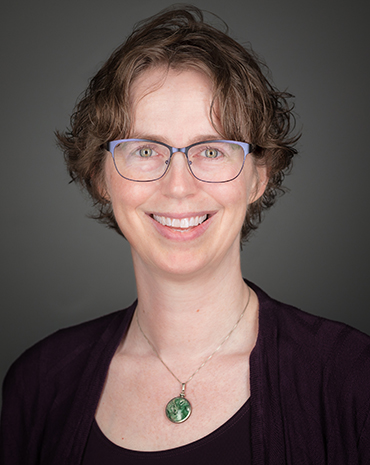
Shelley Tworoger, Phd, Associate Center Director of Population Science
“It’s going to slow down discovery, for example, in developing new therapies or figuring out better ways to allow people to get screening or to stop smoking,” said Tworoger. “Research surrounding human subjects is going to be delayed not just at Moffitt, but everywhere, and that has major implications for the advancement of how we prevent and cure cancer.”
Still, Moffitt was able to keep the majority of clinical trials open during the pandemic, at least for those patients already on the trial.
“Some sponsors did shut down the trials and that meant our patients for whom that might have been their best chance or best hope weren’t able to get access or get access as rapidly, so that has a direct clinical impact,” said Tworoger.
Once clinical operations were back up and running in the summer, it was time to get the scientists back into the lab. But before they could return, Moffitt set up new screening checkpoints at entrances and established new safety protocols, such as limiting lab capacity to 50%. All departments had to make sure they had an appropriate amount of personal protective equipment and cleaning supplies. Many lab teams decided to work in shifts to maintain the reduced capacity guidelines; those who can work off campus are continuing to do so as much as possible.
Still a work in progress: fully reopening human subject research back into the clinics. To reduce the number of people inside an exam room, researchers gathering data or working on lifestyle intervention studies have not been allowed, until recently, to attend patient appointments. Since the beginning of the pandemic, patient enrollment in Total Cancer Care has dropped from close to 1,000 patients a month to about 100.
“We are coming up with really creative ways of working with the doctors,” said Tworoger. “Can we give the patient an iPad when they are in clinic so we are capturing them when they’re there, but not having in-person interaction with them?”
Researchers have prioritized studies to determine which coordinators will be present on site and are working with Virtual Health to create designated virtual visits with patients dedicated to research initiatives.
“I think we have some really exciting opportunities,” said Tworoger. “I am not happy COVID happened, but the bright side is that these innovations and new working relationships we developed during this period are really going to benefit our patients and advancing the research moving forward.”
Embracing innovation
Now, instead of the pandemic evoking fear, it gives rise to feelings of solidarity and resiliency. Working together, the women-led teams at Moffitt faced COVID-19 head on. They had to balance the interests of team members, patients and caregivers to care for patients and continue day-to-day operations as safely as possible while information and recommendations were constantly changing. They then had to work together to bring team members back to campus and restart some pre-pandemic practices.
While the goal is to return to some semblance of normal, some changes will stay, and that’s not always a bad thing. Responding to the pandemic gave rise to new innovations, like the curbside clinic. Virtual visits now have a proven role in cancer care and providers will continue to hand pick which patients and appointments are more appropriate for a virtual setting. Moffitt researchers can now use digital platforms to make gathering data even easier. And while difficult at first, many Moffitt team members have found success working from home, which will help the organization better use one of its most precious resources: space.
The new relationships built during the pandemic are also here to stay. Clinicians, researchers and administrators aren’t as siloed now that they have been in the trenches together. They have built a strong foundation based in communication and team work that can be quickly renewed if another wave of the pandemic hits.
“This really was a team effort. No one person at Moffitt could have addressed all of the things that needed to be worked out,” said Tworoger. “I just have so much gratitude to be at an organization where everyone has this core mission together and people are willing to do whatever it takes to meet that mission.”


